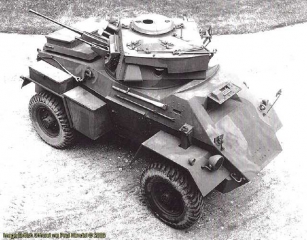One of our members was recently deployed in Iraq, and discovered a veritable “Aladdin’s Cave” of historic armoured vehicles at the former Iraqi army base at Taji (Camp Cook).
It’s hard to imagine just how some of these vehicles found their way here, but their stories must be amazing! The “collection” ranges from Pre-War British (Mark VIB Light Tank) to modern US and British (M60 and Chieftain), the latter we suspect must have been captured during the Iran-Iraq War of the late seventies / early eighties.
Photographed: Taji, Iraq. Photo Series © the photographer via AMMS and text © Peter Hartup 2006.
Vehicles:
UK Mark VIB
UK Humber Armoured Car
US M4 Late 105mm
Light Tank Mark VIB
Notes by Peter Hartup
This vehicle appears to be a Vickers Mark VIB of the type used by British and Commonwealth forces (including Australia) prior to, and in the early stages of WWII. This identification is based on the following points:
- Armour panel with louvres missing so “easiest” point of difference (one or two louvres) between Marks VI & VIA versus VIB not available.
- Mantlet fitting for Vickers, not BESA armament, therefore not VIC.
- Return roller attached to hull, not forward bogie, so not a straight Mark VI, must be either VIA or VIB.
- Round commanders cupola, not octagonal, therefore Mark VIB as opposed to a Mark VIA.
The engine compartment is empty, and with the engine cover missing, a key identification point is missing – whether there are one or two armoured cooling covers. The driver’s seat shown in the images is not original is not in the correct position (should be on the other side of the hull). Likewise the gear shift should be over in the drivers compartment of the front left of the hull. Otherwise the hull and remaining tracks and suspension seem to be in pretty good nick all things considered.
The British used Mk VIs in “constabulary” roles throughout the Middle East and it is likely that this vehicle was part of the force securing the Persian oilfields during WWII.
Even though several major components are missing, these images provide valuable structural information which one rarely sees when various external stowage, covers, drive sprockets and engine components etc are in place. This series should be of use in interpreting drawings etc for those comtemplating a scratch build of this subject.
I am grateful to Paul Handel for reviewing my “identification points”. Nonetheless, any errors remaining are my own!
UK Humber Armoured Car
Wild speculation as to version by Peter Hartup.
For the good oil, please refer to Paul Handel’s Reference Article on UK Humber Armoured Cars.
It is not easy to clearly identify the version, but given the straight line of the front plate (as shown in the first image below) with no step in front of the driver’s hatch (as per Paul’s article), then the odds are (ie my guess is) it’s a Mk II or later.
The images below are from Paul’s article and show the differences between the Mark I and later hulls:
Humber Armoured Car Mk I
Humber Armoured Car Mk II
Humber Armoured Car Mk III
US M4 Late 105mm
Notes by Al Bowie, with additional research by Leife Hulbert
This vehicle appears to be a late M4 105mm but with VVSS Suspension. It would usually have had wet stowage where no applique is fitted. Unfortunately there is no way of telling other than the Hunnicutt bible. I have a suspicion they were all dry stowage as were the M4A2 with late 47 deg hull.
Leife Hulbert has done some digging on this and has confirmed that this vehicle definitely has dry stowage. This is based on a statement in Hunnicutt on pg 261, “(w)ater protection was not applied to the 105mm howitzer tanks, but armored racks were installed”. In the context of the particular chapter, “The Improvements Reach Production”, it is clear that this comment applies to both M4 and M4A3 tanks armed with the 105mm howitzer. Also, there is a clear interior photo of an M4 105mm showing the dry stowage rack in the right forward sponson (pg 269).
The vehicles featured here were ex Commonwealth / Polish Lend Lease stock from WW2 issued to the Iranians under US Military Assistance Program in the late 1940’s. Large depots of stock were located in Iran during the later years of WW2 and a lot of the equipment for the USSR was shipped via there.
The last two images in particular are interesting, showing the old and the new, with the Sherman accompanied by an Apache helicopter hovering in the background.















































